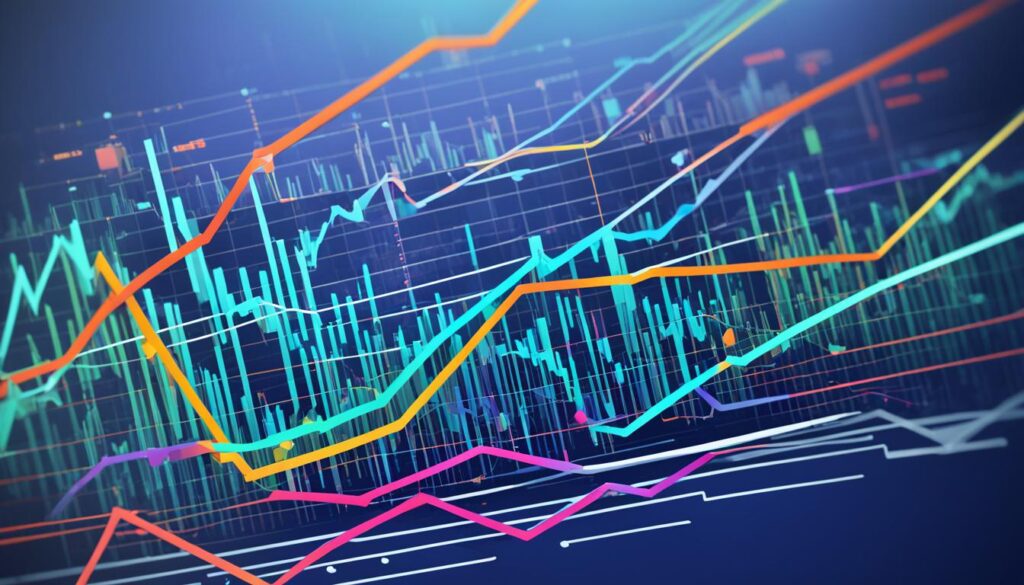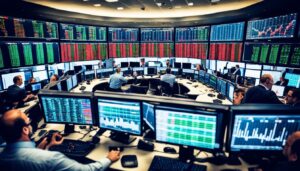Commodity trading is a dynamic and potentially lucrative endeavor. However, achieving success in this competitive market requires more than just luck. It demands the implementation of effective trading strategies that maximize profit potential and manage risks. In this article, I will guide you through the key strategies that can help you thrive in the world of commodity trading.
Key Takeaways:
- Understanding market trends and conducting thorough analysis is vital for devising successful commodity trading strategies.
- Implementing risk management protocols, such as setting stop-loss orders and managing position sizes, is crucial to protect your capital and minimize losses.
- Diversifying your commodities portfolio can help mitigate risks and optimize trading performance.
- Staying informed about market news, economic reports, and industry developments is essential for adapting your strategies to changing market conditions.
- Being adaptable and flexible in your approach will allow you to capitalize on emerging trends and navigate market volatility effectively.
Understanding Market Trends and Analysis
In the world of commodity trading, understanding market trends and conducting thorough analysis is essential for developing effective trading strategies. By staying informed and analyzing key factors that drive commodity prices, traders can make informed decisions and capitalize on market opportunities. In this section, we will explore the importance of market trends and analysis in commodity trading.
The Role of Market Trends
Market trends provide valuable insights into the direction and momentum of commodity prices. By studying supply and demand dynamics, geopolitical events, and economic indicators, traders can identify patterns and trends that influence price movements. Recognizing whether a market is bullish (rising prices) or bearish (falling prices) can help traders determine the most profitable trading strategies.
“The trend is your friend.” – Jesse Livermore
Understanding market trends helps traders anticipate potential price movements, allowing them to enter and exit trades at optimal times. By aligning their strategies with prevailing market trends, traders can increase their chances of success and achieve better risk-adjusted returns.
The Importance of Analysis
Market analysis is a vital component of commodity trading strategies. It involves examining historical data, market indicators, and economic news to gain insights into price patterns and identify potential trading opportunities. Two main types of analysis commonly used in commodity trading are fundamental analysis and technical analysis.
- Fundamental Analysis: This approach involves studying the underlying factors that impact supply and demand dynamics of commodities. Factors such as weather conditions, geopolitical tensions, and economic forecasts can provide valuable information for traders to make informed decisions. Fundamental analysis helps traders assess the intrinsic value of commodities and identify potential price discrepancies.
- Technical Analysis: Technical analysis focuses on studying price charts, chart patterns, and indicators to identify trends and predict future price movements. By analyzing historical price data, traders can spot patterns and utilize various technical indicators to generate trading signals. Technical analysis helps traders make decisions based on market data rather than relying solely on fundamental factors.
Enhancing Trading Strategies
Combining market trends and analysis techniques can significantly enhance commodity trading strategies. By studying market trends and conducting in-depth analysis, traders gain a comprehensive understanding of the commodity market landscape. This knowledge enables them to develop well-informed trading strategies and make better decisions about when to buy or sell commodities.

The image above visually represents the process of market trend analysis in commodity trading. It highlights the importance of monitoring price movements, identifying trends, and utilizing analytical tools to make informed trading decisions. Incorporating market trend analysis into trading strategies can provide traders with a competitive edge in the dynamic commodity markets.
Risk Management and Diversification
Risk management and diversification play a crucial role in the success of commodity trading strategies. As a trader, it is essential to establish effective risk management protocols to protect your capital and minimize losses. This involves setting stop-loss orders, managing position sizes, and adhering to a disciplined trading plan. By implementing these risk management strategies, you can mitigate the potential risks inherent in commodity trading.
Additionally, diversifying your commodities portfolio is key to improving overall trading performance. Investing in different sectors and commodities helps spread the risk and reduces the impact of market volatility on your portfolio. By diversifying, you can effectively hedge against unfavorable price fluctuations in a particular commodity or sector.
Moreover, diversification allows you to take advantage of various opportunities presented by different commodities. Each commodity market behaves differently, influenced by factors such as supply and demand dynamics, global events, and economic conditions. By diversifying, you can tap into multiple markets and increase the potential for profit.
A diversified portfolio may include a mix of energy commodities like oil and gas, precious metals like gold and silver, agricultural commodities like wheat and corn, and industrial metals like copper and aluminum. By spreading your investments across multiple commodities, you can create a balanced portfolio that is more resilient to market fluctuations.
| Benefits of Risk Management and Diversification in Commodity Trading |
|---|
| 1. Protection of capital through risk management protocols |
| 2. Minimization of losses by setting stop-loss orders |
| 3. Effective portfolio diversification to spread risk |
| 4. Reduction of vulnerability to market volatility |
| 5. Opportunity to capitalize on different commodities and sectors |
By incorporating risk management and diversification into your commodity trading strategies, you can enhance your ability to navigate market fluctuations and protect your capital. These principles provide a solid foundation for long-term success in commodity trading.

Staying Informed and Adaptability
In the dynamic world of commodity trading, staying informed is the key to success. As a trader, I understand the importance of continuously monitoring market news, economic reports, and industry developments. By staying informed, I can identify emerging trends and adjust my trading strategies accordingly, enabling me to stay ahead of the curve and capitalize on profitable opportunities.
Adaptability is another crucial trait for successful commodity trading strategies. Market conditions can change rapidly, and being able to adapt and adjust my trading approaches is essential. Whether it’s a sudden shift in supply and demand or a geopolitical event impacting commodity prices, being adaptable allows me to navigate the volatility of the market and make informed decisions.
To stay informed and adaptable, I leverage a variety of resources and tools at my disposal. I regularly follow trusted financial news sources, subscribe to market analysis newsletters, and participate in industry forums and webinars. These resources help me stay up-to-date with the latest market trends, economic indicators, and expert insights.
FAQ
What are some effective strategies for commodity trading?
Effective strategies for commodity trading include understanding market trends and conducting thorough analysis, implementing risk management protocols and diversifying the commodities portfolio, and staying informed and adaptable to market conditions.
How can I understand market trends and conduct analysis for commodity trading?
To understand market trends and conduct analysis for commodity trading, it is important to study factors such as supply and demand, geopolitical events, and economic indicators. Additionally, technical analysis tools and chart patterns can be used to detect trends and patterns in commodity prices.
Why is risk management and diversification important in commodity trading?
Risk management and diversification are crucial in commodity trading to minimize potential losses and improve overall trading performance. By setting stop-loss orders, managing position sizes, and diversifying the commodities portfolio, traders can mitigate risks and enhance their chances of success.
How can I stay informed and adaptable in commodity trading?
To stay informed and adaptable in commodity trading, it is essential to continuously monitor market news, economic reports, and industry developments. This helps identify emerging trends and adjust trading strategies accordingly. Additionally, being adaptable to changing market conditions and adjusting trading approaches when necessary can help capitalize on new opportunities and navigate market volatility.
Source Links
Disclaimer
All information on this website is of a general nature. The information is not adapted to conditions that are specific to your person or entity. The information provided can not be considered as personal, professional or legal advice or investment advice to the user.
This website and all information is intended for educational purposes only and does not give financial advice. Signal Mastermind Signals is not a service to provide legal and financial advice; any information provided here is only the personal opinion of the author (not advice or financial advice in any sense, and in the sense of any act, ordinance or law of any country) and must not be used for financial activities. Signal Mastermind Signals does not offer, operate or provide financial, brokerage, commercial or investment services and is not a financial advisor. Rather, Signal Mastermind Signals is an educational site and a platform for exchanging Forex information. Whenever information is disclosed, whether express or implied, about profit or revenue, it is not a guarantee. No method or trading system ensures that it will generate a profit, so always remember that trade can lead to a loss. Trading responsibility, whether resulting in profits or losses, is yours and you must agree not to hold Signal Mastermind Signals or other information providers that are responsible in any way whatsoever. The use of the system means that the user accepts Disclaimer and Terms of Use.
Signal Mastermind Signals is not represented as a registered investment consultant or brokerage dealer nor offers to buy or sell any of the financial instruments mentioned in the service offered.
While Signal Mastermind Signals believes that the content provided is accurate, there are no explicit or implied warranties of accuracy. The information provided is believed to be reliable; Signal Mastermind Signals does not guarantee the accuracy or completeness of the information provided. Third parties refer to Signal Mastermind Signals to provide technology and information if a third party fails, and then there is a risk that the information may be delayed or not delivered at all.
All information and comments contained on this website, including but not limited to, opinions, analyzes, news, prices, research, and general, do not constitute investment advice or an invitation to buy or sell any type of instrument. Signal Mastermind Signals assumes no responsibility for any loss or damage that may result, directly or indirectly, from the use or dependence on such information.
All information contained on this web site is a personal opinion or belief of the author. None of these data is a recommendation or financial advice in any sense, also within the meaning of any commercial act or law. Writers, publishers and affiliates of Signal Mastermind Signals are not responsible for your trading in any way.
The information and opinions contained in the site are provided for information only and for educational reasons, should never be considered as direct or indirect advice to open a trading account and / or invest money in Forex trading with any Forex company . Signal Mastermind Signals assumes no responsibility for any decisions taken by the user to create a merchant account with any of the brokers listed on this website. Anyone who decides to set up a trading account or use the services, free of charge or paid, to any of the Broker companies mentioned on this website, bears full responsibility for their actions.
Any institution that offers a service and is listed on this website, including forex brokers, financial companies and other institutions, is present only for informational purposes. All ratings, ratings, banners, reviews, or other information found for any of the above-mentioned institutions are provided in a strictly objective manner and according to the best possible reflection of the materials on the official website of the company.
Forex/CFD trading is potentially high risk and may not be suitable for all investors. The high level of leverage can work both for and against traders. Before each Forex/CFD investment, you should carefully consider your goals, past experience and risk level. The opinions and data contained on this site should not be considered as suggestions or advice for the sale or purchase of currency or other instruments. Past results do not show or guarantee future results.
Neither Signal Mastermind Signals nor its affiliates ensure the accuracy of the content provided on this Site. You explicitly agree that viewing, visiting or using this website is at your own risk.


